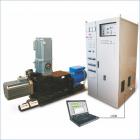| |
|
|
Bench Testers
|
|
| |
| |
 | | | |

|
Bench tester are aimed for testing electric drives, motors, power generators, geared motors, air-powered and hydraulic motors, petrol engines, pneumo and hydraulic actuators with capacity from 90 W up to 60 kW for mass production or incoming inspection. All bench testers when completed go through primary appraisal by specialists from FGU Tomsky CSM.
Bench testers allow setting up and adjusting brake loads, as well as the following technical parameters of the tested devices:
- Load torque
- Rotation rate
- Acceleration and deceleration time
- Value and frequency of generated voltage and currents
|
|

Display System |
The standard bench tester consists of load stand, control cabinet, automated work station.
NOTE!
- Load stands and control cabinets can be supplied separately
- Upon request load stands and control cabinets can be manufactured with functions and parameters required by the Client
- Detachable adapters can be manufactured to fasten various equipment to load stands
|
|
|
|
| |
|
Automated work station allows to control testing both in manual and automatic mode, visualize the set tasks and data signals from tested devices, to perform oscillographic testing of time dependencies for measured parameters and investigate them.
Standard load stand consists of the frame, loading device, torque sensor, rotary rate sensor and hydraulic and mechanical brakes.
Synchronous generator, operating for active load, is used as a loading device when testing drives and motors. It is possible to run the mode of power recuperation into feeding circuit.
The stand can be used for testing electric generators of various types.
Standard control cabinet consists of three phase voltage wiring, voltage converter into required frequency and amplitude, voltage filter network, interface units for connection with PC, high voltage generator of impulse interference, as well as required control and display devices. Control cabinet can be additionally equipped with automated workstation based on PC and required software.
Functions of Control Cabinet
Basic Parameters of Control Cabinet
|
Supply voltage, V
|
~ 380 (50 Hz (3 phases))
|
|
Power of tested electric drive (motor), kW
|
up to 45
|
|
Number of output voltage phases
|
3
|
|
Ranges of output linear voltage, V
|
from 190 to 560
|
|
Ranges of output voltage frequency changes, Hz
|
from 40 to 60
|
|
Ranges of high voltage impulses amplitude changes, V
|
from 500 to 4000
|
|
Ambient temperature, °С
|
from -10 to +35
|
Basic Parameters of Linear Load Testers
| |
Linear Tester for 20 kN
|
Linear Tester for 30 kN
|
|
Ranges of setup and control torque, N
|
0…20000
|
0…30000
|
|
Maximum travel rate, mm/sec
|
50
|
50
|
|
Relative error of torque measurement, %, not more
|
5
|
5
|
|
Dimensions, mm
|
850×500×250
|
850×500×250
|
|
Weight, kg
|
50
|
50
|
Basic Parameters of Rotary Load Testers
| |
SNF-100
|
SNF-10000
|
SNG-20
|
SNG-1000
|
SNG-10000
|
SNG-50000
|
SNV-35
|
|
Ranges of setup and control torque, Nm
|
0…1000
|
100…10000
|
0…20
|
10…1000
|
300…10000
|
500…50000
|
5…120
|
|
Maximum rotary rate of tested equipment, rpm
|
200
|
200
|
5000
|
1500
|
5…60
|
3…12
|
5…120
|
|
Relative error of torque measurement, %, not more
|
5
|
5
|
5
|
5
|
5
|
5
|
5
|
|
Dimensions, mm
|
900×800×450
|
1500×1000×500
|
500×350×250
|
1850×1350×650
|
800×1900×770
|
1600×2000×1500
|
1700×800×650
|
|
Weight, kg
|
60
|
450
|
50
|
650
|
950
|
2000
|
400
|
|
| |
|
|
| |
|
|
| |
|
 Contacts Contacts
|
| |
|
|
| |
|
|
|
|
|
|
|
|